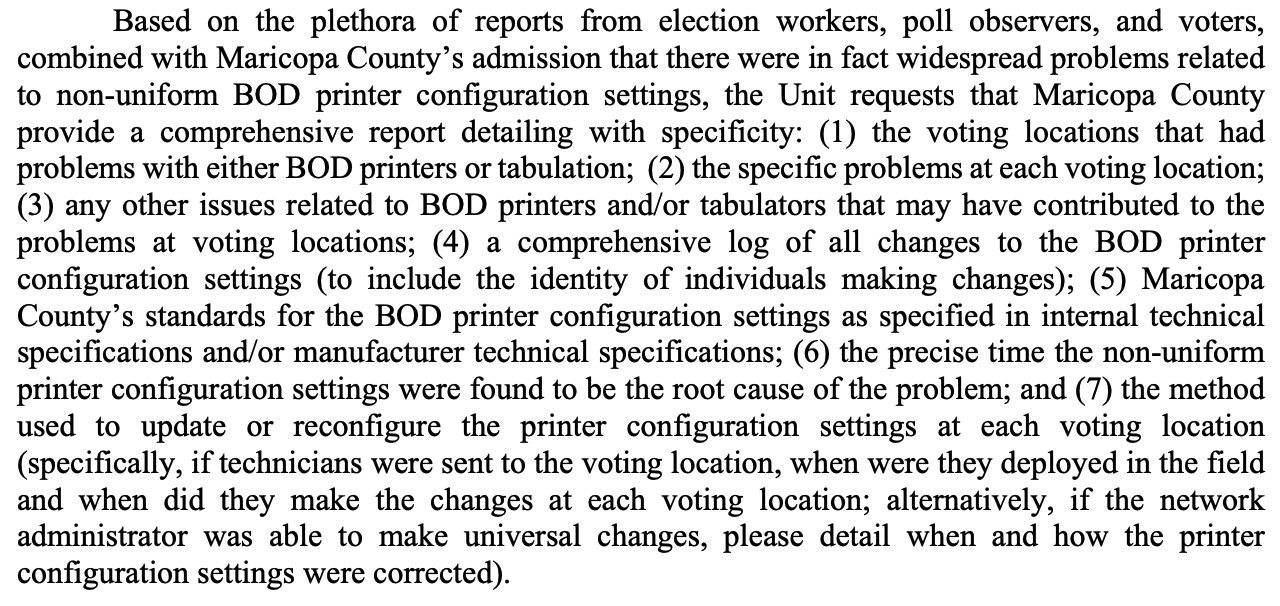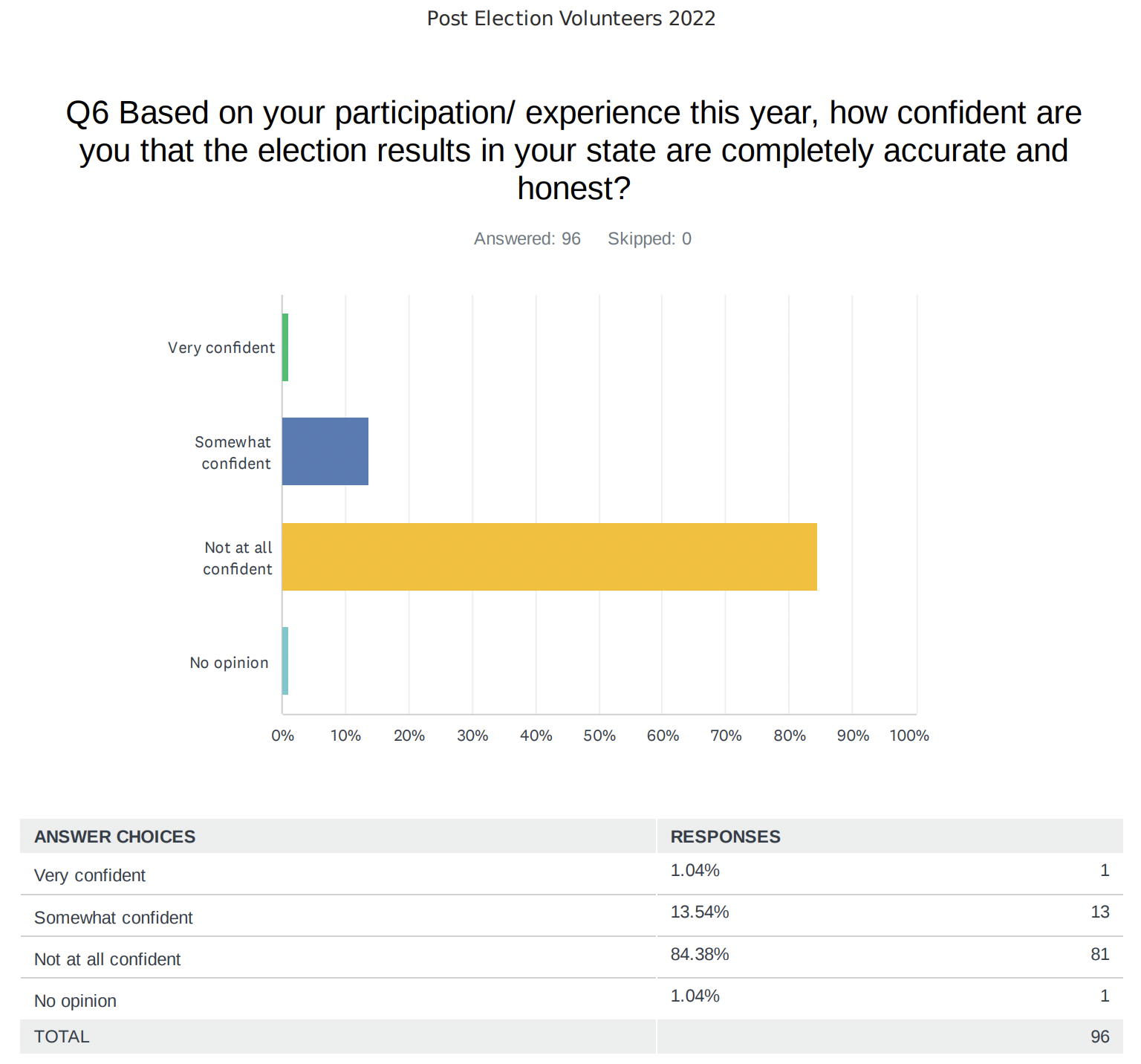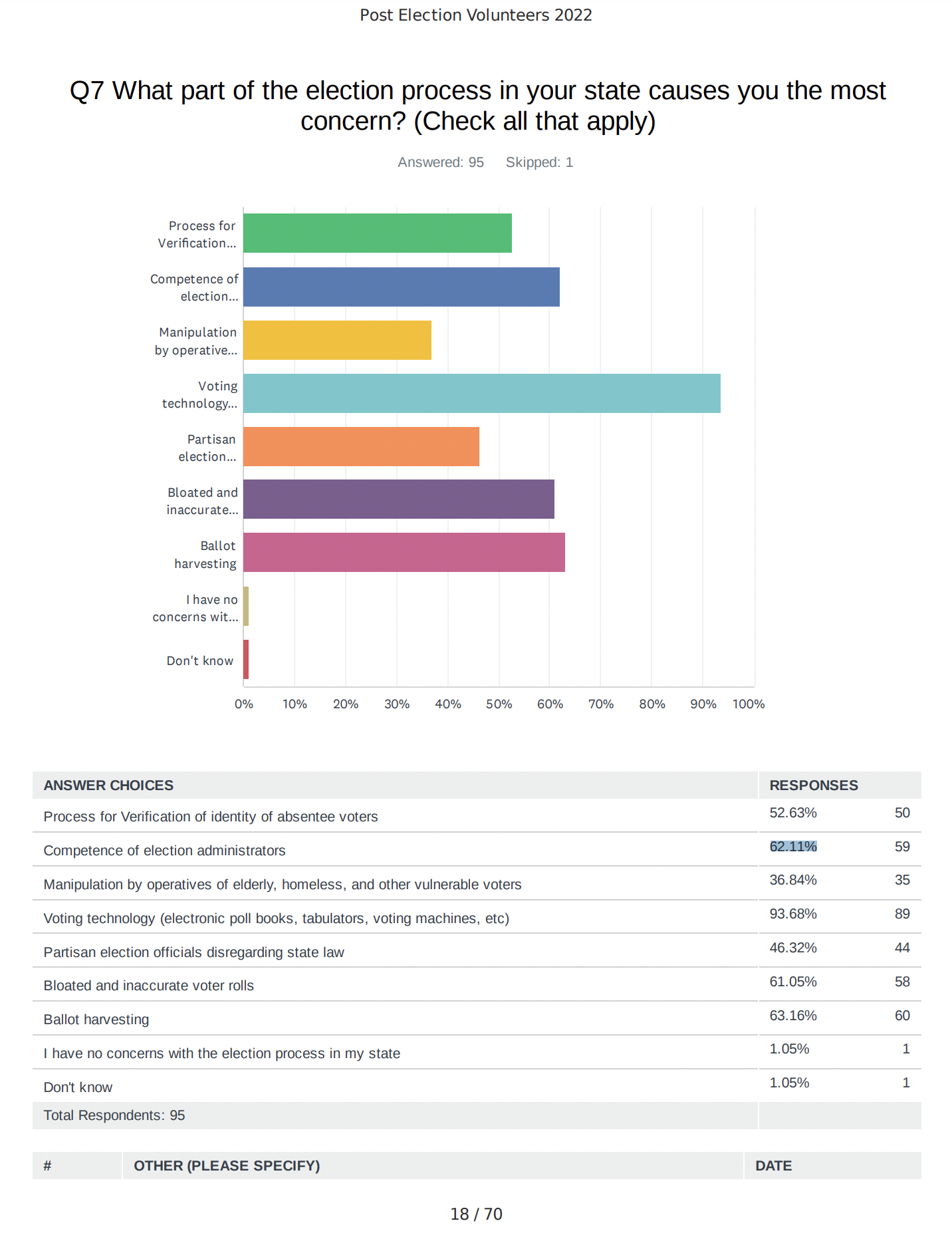Complaints about the Maricopa County 2022 Midterm election have made their way to Arizona Assistant Attorney General Jennifer Wright. On Nov. 19, the Elections Integrity Unit of the Arizona Attorney General's Office wrote a letter admitting having received "hundreds of complaints since Election Day pertaining to issues related to the administration of the 2022 General Election in Maricopa County." Assistant Attorney General Jennifer Wright writes, "these complaints go beyond pure speculation, but include first-hand witness accounts that raise concerns regarding Maricopa's lawful compliance with Arizona election law."
The AG's Elections Integrity Unit requested a response from Thomas Liddy, Civil Division Chief in the Maricopa County Attorney's Office, on or before Nov. 28, the date of the official canvass to the Secretary of State. A volunteer from the Kari Lake campaign contacted Liddy prior to the Assistant AG's letter requesting information from his office. A leaked video from the Lake campaign shows a contentious exchange between the volunteer and Liddy. Liddy appeared to be recalcitrant and rude during the call.
Assistant AG Wright Letter Summarized
Assistant AG Wright seems to acknowledge the numerous issues witnessed at the vote centers. She seems to confirm there were problems with Ballot on Demand (BOD) Printers after having been "tested on Monday, Nov. 7, without any apparent problems." Runbeck provides the Sentio Ballot Printing System for the County's BOD printers. Wright specifically noted the existence of "non-uniform configuration settings" on the printers. She requested any and all information about where the problems occurred and comprehensive logs, standards for configuration settings, updates, etc.:
 BOD Printers/https://www.azag.gov/sites/default/files/2022-11/221119%20Letter%20to%20Maricopa%20County%20re%202022%20General%20Election%20Administration.pdf
BOD Printers/https://www.azag.gov/sites/default/files/2022-11/221119%20Letter%20to%20Maricopa%20County%20re%202022%20General%20Election%20Administration.pdf
Wright also noted "widespread reports of problems at voting locations" involving alleged improper election day check-out procedures that led to difficulties for voters who had already checked in to an e-Pollbook at one location and who then were sent to vote at a second location because of a misread ballot or because of a long wait. "Sworn complaints" indicated "poll workers reported that they were not trained" properly on how to execute "check out procedures." In some cases, it seems voters were instructed to cast a provisional ballot in the second location. However, Wright's letter clarifies that Arizona law "specifically prohibits provisional ballots to be counted when a voter has signed multiple poll books. See A.R.S. 16-584(D)."
Wright's letter also confirmed the placement of "Door #3" ballots into black duffle bags intended to be used for tabulated ballots. She requested a written report to confirm the number of "commingled ballots," whether the county was aware of such problems, and "how these problems were ultimately resolved." Wright also requested end-of-the-day reconciliation reports to "verify ballots cast against check-ins." UncoverDC reported eyewitnesses stated reconciliation reports were out of balance in some locations.
Eye Witness Reports Consistent Across the Board
UncoverDC has written three reports documenting first-hand accounts of problems at the polls on Election Day; tabulator issues, confusion over how to handle Door 3 ballots, long lines, alleged failure to follow the rules, and chain of custody issues. Those observations are now corroborated by other eyewitnesses, including a Nov. 15 letter from a group of "roving attorneys from the Republican National Committee's (RNC) Election Integrity program in Arizona" and Cleta Mitchell's Election Integrity Network. Her organization surveyed election volunteers post-election, again finding many of the same problems. Election Integrity Network and Who's Counting with Cleta Mitchell is a project of the Conservative Partnership Institute, according to the website.
17 Roving Attorneys Provide Eyewitness Accounts
Attorney Mark Sonnenklar submitted a summary of the eyewitness accounts made by a team of attorneys on behalf of the RNC's Election Integrity program in Arizona. He and 16 other "roving attorneys" went to several vote centers throughout Maricopa County on Nov. 8. Ultimately, 10 out of the 16 other attorneys responded to the survey, which was a basis for his summary. He and the 16 other attorneys observed: "a total of 115 vote centers out of a total of 223 vote centers in the County (51.56% of the total vote centers in the County.)." Notably, Sonnenklar was also a roving attorney during the primary election on Aug. 2. Per his summary, he observed: "ubiquitous issues with the tabulators and printers on that day as well."
Sonnenklar concludes that it "seems very clear that the printer/tabulator failures on election day at 62.61% of the vote centers and the resulting long lines at the majority of all the vote centers led to substantial voter suppression." He also noted that "Republican voters significantly outnumbered Democrat voters in the County on election day." Therefore, "such voter suppression would necessarily impact the vote tallies for Republican candidates much more than the vote tallies for Democrat candidates." On Nov. 8, Chairman of Maricopa County's Board of Supervisors Bill Gates stated that about "20 percent of the vote centers" had issues with tabulators.
Sonnenklar visited 11 vote centers, 10 of which he observed and took notes.
 Sonnenklar Vote Centers/https://whoscounting.us/wp-content/uploads/2022/11/Aggregated-Roving-Attorney-General-Election-Report1741.pdf
Sonnenklar Vote Centers/https://whoscounting.us/wp-content/uploads/2022/11/Aggregated-Roving-Attorney-General-Election-Report1741.pdf
Sonnenklar spoke with Republican Observers and the polling inspector at each center. In all but three of his observed centers, there were significant issues with the functioning of tabulators. The tabulator malfunctions caused misreads, resulting in the repeated rejection of ballots in most cases throughout the day. In some cases, the machines were reset. The ballot rejection rates ranged from 10% to 90%, depending on the location.
Printer Problems
Printers were not printing ballots properly, which led many poll workers to conclude that poor print quality (faded, greyscale markings on the ballots) led to the ballot misreads by the tabulators. There were no available printers to replace the malfunctioning ones, according to observations from the vote center Venue 8600. There had been repeated calls for adequate toner for the printers by the GOP before the election. At the Palm Ridge Rec Center (Exhibit B of summary), they ran out of toner for both printers simultaneously. Inspector Jamie Alford reported, "No one could vote for an hour and a half. This is how long it took the county to bring new toner." It was a "strong Republican area," Alford reported. In some of the cases, even when the toner was replaced, Sonnenklar reported the toner replacement "improved the functioning of the tabulators a little bit, yet they were still failing at a very high rate." (Islamic Center)
Improper Handling of Ballots
In many cases, ballots were not properly handled after having been rejected. They were either not spoiled immediately or, in some cases, left unattended. (Islamic Center)
 Islamic Center/Sonnenklar
Islamic Center/Sonnenklar
Once a ballot is rejected, it must immediately be marked spoiled, and the bars at the top and the bottom of the ballot must be struck through. A voter is limited to spoiling "only two ballots at a voting location, after which they will be offered a provisional ballot," according to the 2022 Maricopa County Poll Worker Manual.
 Proper Spoiling of Ballot after Misread/https://elections.maricopa.gov/asset/jcr:2f02b340-4bc1-4782-8fa1-9813afabb37a/FINAL%202022%20Primary%20General%20Manual_Redacted1.pdf
Proper Spoiling of Ballot after Misread/https://elections.maricopa.gov/asset/jcr:2f02b340-4bc1-4782-8fa1-9813afabb37a/FINAL%202022%20Primary%20General%20Manual_Redacted1.pdf
The voters who chose not to spoil their ballots and vote again were instructed to put their ballots in Door #3. The roving attorneys stated many voters voiced concerns that their vote would never be counted. Some called it the "I hope it gets counted box." Roie Bar reported there were two lines outside Dove of the Desert United Methodist Church; one for those trying to vote for the first time and the other "for voters who got back in line to try and run their ballots again." Others were sent to another location with "his ballot in hand." According to the manual, voters aren't supposed to leave the building with a marked ballot.
Chain of Custody/Not Following Procedures
Their concerns are not unwarranted because, in most cases, the rejected ballots were placed in the black duffle bags set aside for voted ballots only, thus commingling counted and uncounted ballots. Per the manual, Door #3 ballots were to have been placed in the Misread Ballots envelope, and the Blue Box, which was reserved for misread ballots, hand-delivered election-day mail-in ballots, and provisional ballots.
 Black Bag/Voted Ballots/Maricopa County Elections/https://elections.maricopa.gov/asset/jcr:2f02b340-4bc1-4782-8fa1-9813afabb37a/FINAL%202022%20Primary%20General%20Manual_Redacted1.pdf
Black Bag/Voted Ballots/Maricopa County Elections/https://elections.maricopa.gov/asset/jcr:2f02b340-4bc1-4782-8fa1-9813afabb37a/FINAL%202022%20Primary%20General%20Manual_Redacted1.pdf
At the North Scottsdale United Methodist Church vote center, an observer told Sonnenklar a U.S. Postal Service employee from the Evans Post Office "brought a box of mail-in-ballots postmarked on or before election day to the vote center." County election headquarters allegedly told the Inspector at the location it was "okay to accept the mail-in ballots from USPS." According to the National Conference of State Legislatures (NCSL) website, Arizona statute allows only "a family member, household member, or caregiver" to return an absentee/mail ballot on behalf of a voter. Roving attorney Kevin Beckwith noted a poll watcher observed, "one man drop of 10 ballots at one time which were accepted."
 AZ Mail Ballot Return/NCSL
AZ Mail Ballot Return/NCSL
Almost all locations experienced long lines, resulting in some voters leaving without voting.
Whosecounting.us Survey
Cleta Mitchell's organization, The Election Integrity Network (found at whosecounting.us,) published a post-election survey of observations submitted mostly by poll workers and paid election workers for Maricopa County's November election. There were 96 respondents, with 66.67% (64 total) poll workers and 28.13% (27) paid election workers. Of those who responded, 84.38% were "not at all confident" the election results in the state were "completely accurate and honest."
 Whosecounting.us/https://whoscounting.us/wp-content/uploads/2022/11/Data_All_221118.pdf
Whosecounting.us/https://whoscounting.us/wp-content/uploads/2022/11/Data_All_221118.pdf
Voting technology was far and away at the top of their concerns. Almost 94% of the respondents said the technology is problematic. The second and third-place winners at 63.16% and 62.11%, respectively, were concerned about ballot harvesting and the competence of election administrators.
 whosecounting/Cleta Mitchell Survey
whosecounting/Cleta Mitchell Survey
Whosecounting also asked respondents whether they "were able to observe whether the number of votes each day matched the number of voters who signed in and were recorded as having voted that day (or, cumulatively, for that location)?" The majority responded no at almost 66% (p. 36)
Pages 37-40 show brief descriptions from respondents noting incidents, issues, and problems on election day. One worker summarized her experience with the tabulators, "The [tabulators are the] biggest and most important pieces of the voting puzzle, and they worked as well as an old car with no tires. Outrageous." Another said no one counted the absentee ballots for chain-of-custody and another stated the security for ballot drop delivery at the end of the day was an "absolute joke." (p. 40) Another respondent shared that s/he knows the voter rolls are "not maintained" because s/he called "voters prior to the election and discovered people I had made contact with are now living in other States within the U.S." (p. 49). One respondent commented on her experience with Maricopa County's system of having voters update and verify their address and signature at the polls:
"The Maricopa County system of having voters update their address[es] at the polls has corrupted the voter registration signatures. Voter's updating their registration at the polls signed with their finger in a white box on a vertical computer screen. As a poll worker checking voters in, many voters apologized that the signature looks nothing like their real signature, and many just made a squiggly line. These signatures will be worthless for signature verification of mail-in or early ballots that are signed with an ink pen in the future." (Pp.50,51)


